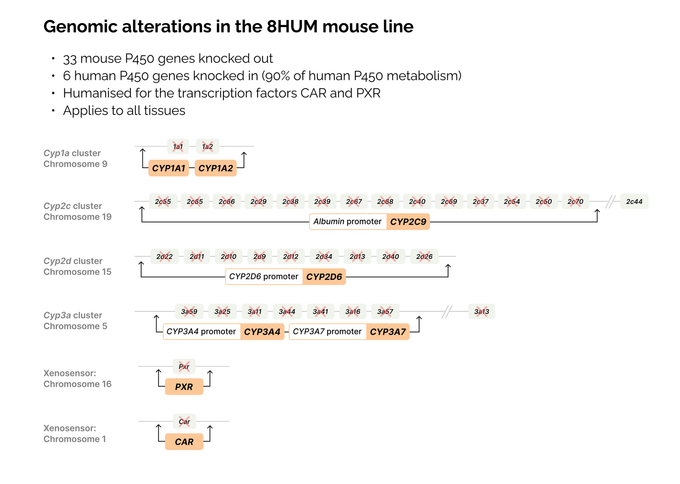
The 8HUM Model
The 8HUM mouse is a model in which essentially all the mouse Cytochrome P450 proteins have
been deleted and replaced by all of the major human Cytochrome P450s.
This mouse has been 20 years in creation. It has been extensively characterised and results published in peer reviewed journals.
8HUM mice uniquely metabolise compounds in a human specific way. It is the only rodent model able to give human like plasma levels of compounds, and human like metabolites.
A mouse has been created that metabolizes drugs like humans.
This model gives more human-like pharmacokinetics.
Generates human drug metabolites in vivo.
8HUM circumvents mouse metabolism issues
Saves time and money to deliver clinical success


Transforming the Drug Discovery Paradigm with a Mouse Model Humanized for Drug Metabolism
In order to circumvent the limitations of animal models to study drug efficacy and to create a more human like model for drug development, PhaSER Bio has created a Mouse Model Humanised for Drug Metabolism: 8HUM. We have substituted 33 murine cytochrome P450s from the major gene families involved in drug disposition in man, together with the transcription factors Car and Pxr, for six human P450 genes and human PXR and CAR. The result is a mouse model which covers 90% of P450-mediated metabolism in man (Henderson et al Drug Metab Dispos (2019))
Our model can accelerate the drug development process by:
- Progressing compounds in drug discovery programmes which otherwise would have been seriously compromised. Since mice metabolize drugs much faster than humans, it can be a major challenge to obtain drug exposures for drug efficacy studies. Drug pharmacokinetics (PK) and metabolite profiles obtained in 8HUM are in much better alignment with clinical observations than wild type mice.
- Accelerating the drug development process circumvents the need to optimise compounds for mouse-specific metabolism issues.
- Defining pharmacokinetics and pharmacodynamics relationships for single agents and drug combinations.
- Predicting drug-drug interactions (DDIs) in vivo, both for loss of drug efficacy and toxicity. In the longer term development of accurate computational predictions of DDIs.
- Optimising the design of clinical trials by the more informed choice of drug doses and dosing regimens for combination therapies, while at the same time minimising the risk of drug-drug interactions.
Using an in vivo model with human metabolism will circumvent mouse metabolism issues and give more accurate predictions of human drug responses. This will save time , resources and money and accelerate the delivery of new drugs into the market.